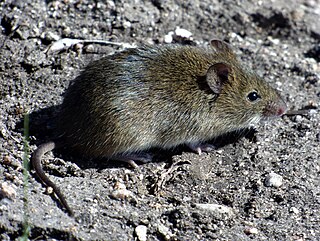
Akodon is a genus consisting of South American grass mice. They mostly occur south of the Amazon Basin and along the Andes north to Venezuela, but are absent from much of the basin itself, the far south of the continent, and the lowlands west of the Andes. Akodon is one of the most species-rich genera of Neotropical rodents. Species of Akodon are known to inhabit a variety of habitats from tropical and tropical moist forests to altiplano and desert. Fossils are known from the late Pliocene onwards.
Neacomys musseri, also known as Musser's neacomys or Musser's bristly mouse, is a rodent species from South America. It is found in far western Brazil and southeastern Peru.
Neacomys paracou, also known as the Paracou neacomys or Paracou bristly mouse, is a rodent species from South America in the genus Neacomys. It is found in northern Brazil, French Guiana, Guyana, Suriname and southeastern Venezuela.
Brucepattersonius igniventris, also known as the red-bellied akodont or red-bellied brucie, is a South American rodent in the genus Brucepattersonius. It is known only from a few specimens from the type locality in Iporanga, São Paulo, Brazil. Although it is threatened by habitat loss, it is protected by Alto Ribeira Tourist State Park.
Zygodontomys brevicauda, also known as the short-tailed zygodont, short-tailed cane mouse, or common cane mouse, is a species of rodent in the genus Zygodontomys of tribe Oryzomyini.
The Bogotá grass mouse or Bogotá akodont, is a species of rodent in the family Cricetidae. It is found in the Andes eastern and central Colombia and northwestern Venezuela. Alavarado-Serrano and D'Elía (2013) have assigned the species to a new genus, Neomicroxus along with Neomicroxus latebricola.
Akodon boliviensis, also known as the Bolivian grass mouse or Bolivian akodont, is a species of rodent in the family Cricetidae. It is found in the Andes from southeastern Peru through Bolivia into northwestern Argentina.
Akodon budini, also known as Budin's akodont or Budin's grass mouse, is a species of rodent in the family Cricetidae. It is found in the Andes of northwestern Argentina and adjacent Bolivia. The species is named after Emilio Budin, an Argentine specimen collector who worked with Oldfield Thomas.
Abrothrix illuteus, also known as the gray akodont, gray grass mouse, or gray soft-haired mouse, is a species of small rodent in the genus Abrothrix of family Cricetidae. It is found only in northwestern Argentina.
Abrothrix lanosa, also known as the woolly grass mouse or woolly akodont, is a species of rodent in the family Cricetidae. It is found in southern Argentina and Chile. It was previously classified in the genus Akodon rather than Abrothrix.
Abrothrix olivacea, also known as the olive grass mouse or olive akodont, is a species of rodent in the genus Abrothrix of family Cricetidae. It is found from northern Chile into southern Chile and Argentina, including the islands of Tierra del Fuego. It is prone to large swings in population size.
The Altiplano grass mouse is a species of rodent in the family Cricetidae. It is found in Bolivia, and Peru.

Akodon spegazzinii, also known as Spegazzini's akodont or Spegazzini's grass mouse, is a rodent in the genus Akodon found in northwestern Argentina. It occurs in grassland and forest at 400 to 3,500 m above sea level. After the species was first named in 1897, several other names were given to various populations now included in A. spegazzinii. They are now all recognized as part of a single, widespread and variable species. Akodon spegazzinii is related to Akodon boliviensis and other members of the A. boliviensis species group. It reproduces year-round. Because it is widely distributed and common, Akodon spegazzinii is listed as "least concern" on the IUCN Red List.
The pleasant bolo mouse, or pleasant akodont, is a species of rodent in the family Cricetidae. It is found on grassland at high altitudes in Bolivia and Peru.
The Andean vesper mouse is a species of rodent in the family Cricetidae. It is found in Argentina, Bolivia, Chile, and Peru.
Abrothrix andina, also known as the Andean Altiplano mouse or Andean akodont, is a species of rodent in the genus Abrothrix of family Cricetidae. It is found in the Altiplano habitat of the Andes from central Peru through Bolivia, south to Argentina and Chile.
Nesoryzomys fernandinae, also known as the Fernandina nesoryzomys, Fernandina rice rat, or Fernandina Galápagos mouse, is a species of rodent in the genus Nesoryzomys of family Cricetidae. It is found only on Fernandina in the Galápagos Islands, which it shares with N. narboroughi. Its natural habitat is subtropical or tropical dry shrubland. The conservation status of this endemic species continues to be investigated.
Zygodontomys brunneus, also known as the brown zygodont, brown cane mouse, or Colombian cane mouse, is a rodent species in the genus Zygodontomys of tribe Oryzomyini. It is found only in Colombia.

Akodon caenosus is a rodent in the genus Akodon found in northwestern Argentina and south-central Bolivia. Since its description in 1918, it has been alternatively classified as a separate species or a subspecies of Akodon lutescens. The species Akodon aliquantulus, described from some very small Argentine specimens in 1999, is now recognized as a synonym of A. caenosus.
Geoxus annectens, also known as Pearson's long-clawed akodont or Pearson's long-clawed mouse, is a species of rodent in the tribe Abrotrichini of family Cricetidae. Molecular data suggests that its closest relative is Geoxus valdivianus. Formerly classified in its own genus, Pearsonomys, named after American zoologist Oliver Payne Pearson, it was moved to Geoxus in 2016 after a morphological and genetic reevaluation of the tribe Abrotrichini. This rodent is endemic to Chile, where it is found in Nothofagus forest of the Valdivian temperate rainforest ecoregion.




